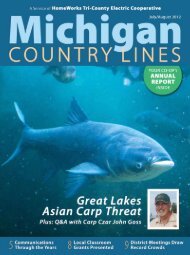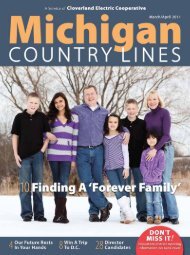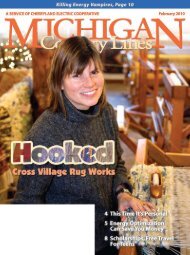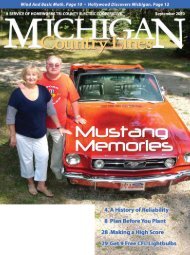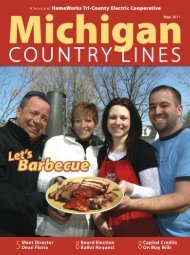Cherryland Electric Cooperative - Michigan Country Lines Magazine
Cherryland Electric Cooperative - Michigan Country Lines Magazine
Cherryland Electric Cooperative - Michigan Country Lines Magazine
Create successful ePaper yourself
Turn your PDF publications into a flip-book with our unique Google optimized e-Paper software.
More About Vernors<br />
I called the Snapple Co.<br />
again,and they said, “Yes, it<br />
is aged for three years in barrels”<br />
(there is a telephone number<br />
on the bottle). Also, they<br />
haven’t changed the recipe in<br />
over 40 years. The above is in<br />
answer to the letter in the last<br />
<strong>Country</strong> <strong>Lines</strong> (July-August).<br />
I have had a lot of good<br />
comments about the article<br />
(June <strong>Michigan</strong>-made product,<br />
“Memories and History of<br />
Vernors Ginger Ale”).<br />
– Marjory Priest<br />
Kayaks<br />
To your article in <strong>Country</strong> <strong>Lines</strong><br />
(July-August 2011) on kayaks,<br />
the picture is staged—you do<br />
not see water movement and<br />
the paddles are in the wrong<br />
position—the one out of the<br />
water has to be at 90 degrees to<br />
the one in the water to reduce<br />
air flow. And, I have not seen<br />
any kayak on display or in<br />
the water that would be long<br />
enough, so it would not waddle<br />
like a duck unless it is an original<br />
“Eskimo” or a “Klepper.”<br />
I was about 5-years-old when<br />
I first sat in a kayak—this is a<br />
little more than 80 years ago.<br />
We did not have any canoes, just<br />
kayaks going down the Mosel<br />
and Rhein rivers. Those kayaks<br />
were not plastic-they had<br />
a wooden frame and a canvas<br />
skin. Since 1963, I’ve owned<br />
a 17-foot (not seaworthy any<br />
more) folding kayak with a rudder<br />
sideboard and sail. Sometimes<br />
I think to take it out again,<br />
fix it, and play with it again.<br />
– Hans Mueller, LeRoy<br />
Editor’s Note: It’s great that<br />
you have a long history with this<br />
wonderful sport and we hope you<br />
get to use your kayak again. As<br />
to the photo, we sometimes use<br />
“stock” photos and do not claim<br />
these are professional kayakers,<br />
but the photo gives readers an<br />
idea of what kayaks look like<br />
and the fun that can be had with<br />
them, which is our main intent<br />
for this story. Thanks.<br />
More About Eagles<br />
Regarding Don Ingle’s article,<br />
(May, “High-Flying Eagles”)<br />
how many bald eagles are currently<br />
nesting in <strong>Michigan</strong>?<br />
What county has the most?<br />
Least? How many counties are<br />
they nesting in?<br />
– William Robson, Whitmore Lake<br />
Don Ingle replies: “According<br />
to Mathew Stuber of the U.S.<br />
Fish and Wildlife Service, <strong>Michigan</strong>’s<br />
population of American<br />
bald eagles is about 700 pairs,<br />
and they are now widespread in<br />
<strong>Michigan</strong>. Their favorite nesting<br />
sites are near large bodies of<br />
water, like rivers and lakes, as<br />
they are primarily fish eaters,<br />
although they will eat carrion.<br />
After nearly becoming extirpated<br />
from <strong>Michigan</strong>, their population<br />
rebound is one of conservation’s<br />
best success stories. Many consider<br />
passage of the Clean Waters Act<br />
in the 1970s to be the major<br />
reason for the recovery, since<br />
eagles eat fish and if fish were<br />
from contaminated waters it led<br />
to hatching failures.<br />
The highest number of eagles<br />
are found in the U.P. and northern<br />
half of lower <strong>Michigan</strong>, but<br />
they are now being seen in a<br />
majority of <strong>Michigan</strong>’s counties.<br />
To Send Us a Letter:<br />
We enjoy hearing from our readers,<br />
so if you wish to comment,<br />
email your letter to editor@countrylines.com<br />
or send to: <strong>Country</strong><br />
<strong>Lines</strong> Letters, 2859 W. Jolly Rd.,<br />
Okemos, MI 48864.<br />
Letters are printed on a<br />
space-available/content basis,<br />
and we reserve the right to edit<br />
slightly for space reasons. Since<br />
there isn’t room to print every<br />
letter, please keep the size to no<br />
more than 350 words so we can<br />
include as many as possible.<br />
Thanks for reading with us!<br />
College Fire Safety<br />
While college provides new and exciting opportunities,<br />
it also introduces safety hazards, especially to students<br />
living in dormitories, apartments and other community<br />
locations. An impeccable personal safety record doesn’t safeguard<br />
someone against the actions of other residents in shared college<br />
housing facilities. Therefore, it is extremely important to develop<br />
and practice an escape route should there be a fire.<br />
Fire Safety<br />
Fire is the third leading cause of accidental deaths in the United<br />
States. A residential fire occurs every 82 seconds in this country,<br />
and, once burning, the size of a fire doubles every 30 seconds. If<br />
a fire occurs in your building, evacuate as soon as possible. Do<br />
not try to act bravely or put the fire out. That is a fight too easily<br />
lost and is just not worth it.<br />
If you have an escape plan, follow<br />
it at the first sign or smell of a fire.<br />
Never exit a door if it feels hot to<br />
the touch, as flames are likely on the<br />
other side. It is also a good idea to<br />
know where all the fire extinguishers<br />
are located in the building.<br />
Fire Prevention<br />
In community living facilities, everyone<br />
must do their part to make their<br />
dwelling a safer place. Here are a few<br />
easy steps you can take to help prevent<br />
fire through electrical hazards:<br />
u Look for the Underwriters<br />
Stay safe—don’t overload<br />
power strips!<br />
Laboratories (UL) mark on all products. It means they have<br />
been tested for safety.<br />
u Make sure outlets are not overloaded.<br />
u Check electrical wires and cords on appliances, tools, lamps,<br />
etc., to make sure they are not worn or frayed.<br />
u Never run electrical wires or extension cords under carpets<br />
or heavy items, and never bunch them up behind a hot appliance.<br />
u Unplug appliances when not in use.<br />
u Make sure there is at least one smoke alarm on each level,<br />
and make sure they are maintained and tested regularly.<br />
Fire facts<br />
Fire is a chemical reaction involving fuel, oxygen and heat. Take<br />
away any of these elements and a fire cannot last. There are four<br />
classifications of fires, depending on their fuels:<br />
Class A – Ordinary materials like wood, paper, cloth, rubber,<br />
and plastics. Most home fires fall into this category.<br />
Class B – Combustible liquids—gasoline, kerosene, alcohol,<br />
paint, and propane—tend to be more severe and dangerous than<br />
Class A fires because the fuel is highly flammable.<br />
Class C – <strong>Electric</strong>al equipment like appliances, switches, and<br />
power tools. These fires are extremely dangerous due to added<br />
shock hazards and because the source is energized. An energized<br />
fire source supplies a steady and constant ignition condition.<br />
Class D – Combustible metals like magnesium, titanium, potassium,<br />
and sodium. These fires burn at a very high temperature<br />
and can react violently with water or other chemicals.<br />
– Source: Underwriters Laboratories<br />
September 2011 | 7




